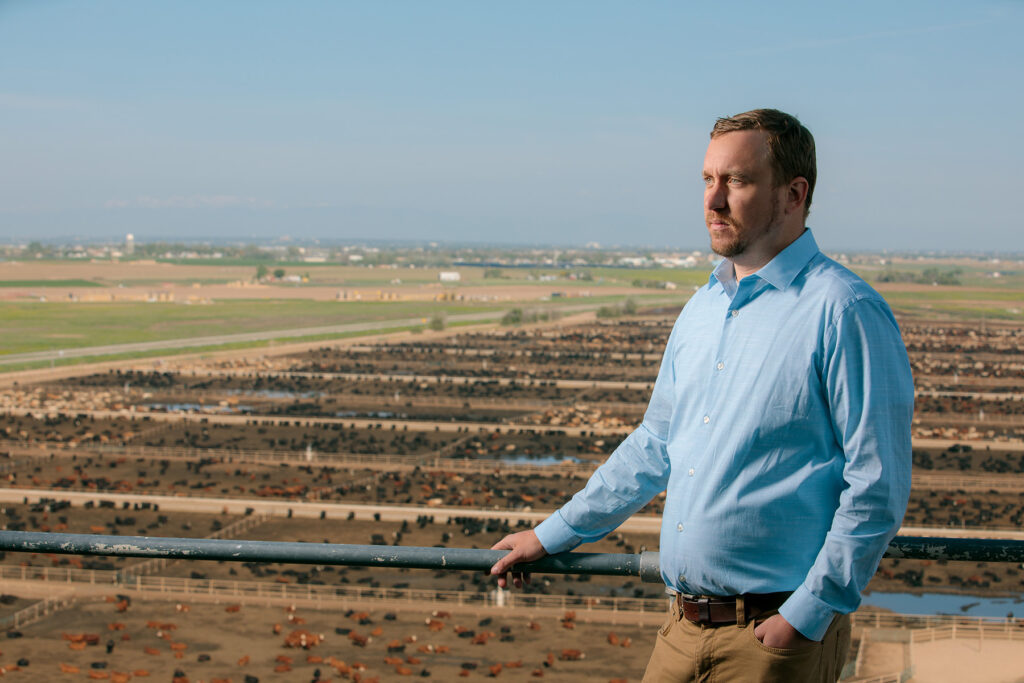
KNOWLEDGE ECONOMY
In the world of tech transfer, every patent tells a story
By Coleman Cornelius | Photography by Matthew Staver
July 17, 2023
WHEN HE WAS 8 years old, Lucas Loetscher and his grandfather held a contest to decide who could grow the best tomatoes.
In early summer, they planted tomato starts at their family farm near Cheyenne, Wyoming. Lucas fertilized his with Miracle-Gro. Grandpa Loetscher fertilized his tomatoes with “manure tea” – a concoction made by scooping cured cattle manure into a burlap sack, tying the sack, and suspending it in a bucket of water like a tea bag. Water leaches nutrients from the manure, and the solution may be poured onto garden soil to give plants a boost.
His grandfather won the contest, producing beautiful homegrown tomatoes. Lucas overfertilized and killed his plants. But he latched onto a lesson that would later figure prominently in his scientific and business aspirations.
Fifteen years after the tomato contest, Loetscher was earning a master’s degree in civil engineering at Colorado State University and analyzing a method for extracting useful compounds from manure. The process under investigation was not feasible for large-scale application. Then Loetscher remembered the manure tea. What if he added a step to the extraction process and recirculated liquid to leach valuable compounds from waste – like making manure tea, but using precisely engineered equipment at commercial scale?
INVENTIONS AND TECH TRANSFERS AT CSU
| FY | 2018 | 2019 | 2020 | 2021 | 2022 | 5 YR TOTAL |
|---|---|---|---|---|---|---|
| Inventions disclosed | 113 | 127 | 116 | 96 | 71 | 523 |
| IP protections issued* | 53 | 47 | 67 | 62 | 44 | 273 |
| Licenses attained | 36 | 52 | 32 | 47 | 32 | 199 |
| New startups | 5 | 6 | 5 | 5 | 4 | 25 |
|
Total revenue** ($ million) |
1.82 | 3.80 | 2.09 | 4.07 | 3.10 | 14.88 |
*Patents, trademarks, copyrights
**Generated by patents, trademarks, and copyrights on CSU faculty innovations
That fundamental concept became the basis of patented technology that promises a new way of producing renewable natural gas from cattle manure.
Loetscher’s invention is a novel digester for solid waste. He developed it with his graduate adviser, Sybil Sharvelle, whose research interests include conversion of waste to energy. If the digester is successful as a commercial product, it will transform an oversupply of livestock manure and untold landfill waste into biogas – efficiently converting refuse from farms and cities into pipeline-quality gas and yielding a useful soil amendment at the end. Because the digester is enclosed, it could also cut environmental emissions of methane from municipal landfills and livestock operations, where the potent greenhouse gas arises during open-air waste handling.
“The idea that we could have an impact is very fulfilling,” Loetscher said. “It feels like the right thing to do.”
Like some existing technologies, Loetscher’s innovation incorporates anaerobic digestion, using hungry microbes to decompose solid waste in a sealed tank. As a byproduct, the microbes produce methane gas that is collected and purified into renewable natural gas, which is ready for use. But, unlike conventional technologies, Loetscher’s digester includes a key additional step, called upflow liquid recirculation – the function inspired by manure tea. Put together, its workings allow the digester to handle a wide variety of solid waste, even contaminated material, without the need for preprocessing. That means the complete production process uses less energy, and often less water, to produce biogas.
“Companies are working to reduce their carbon dioxide emissions, and they’re motivated to decarbonize their entire supply chain. They want to solve problems end-to-end,” said Loetscher, who is now working on a doctorate in environmental engineering at CSU. “The final product has less total environmental impact when the waste is handled efficiently.”
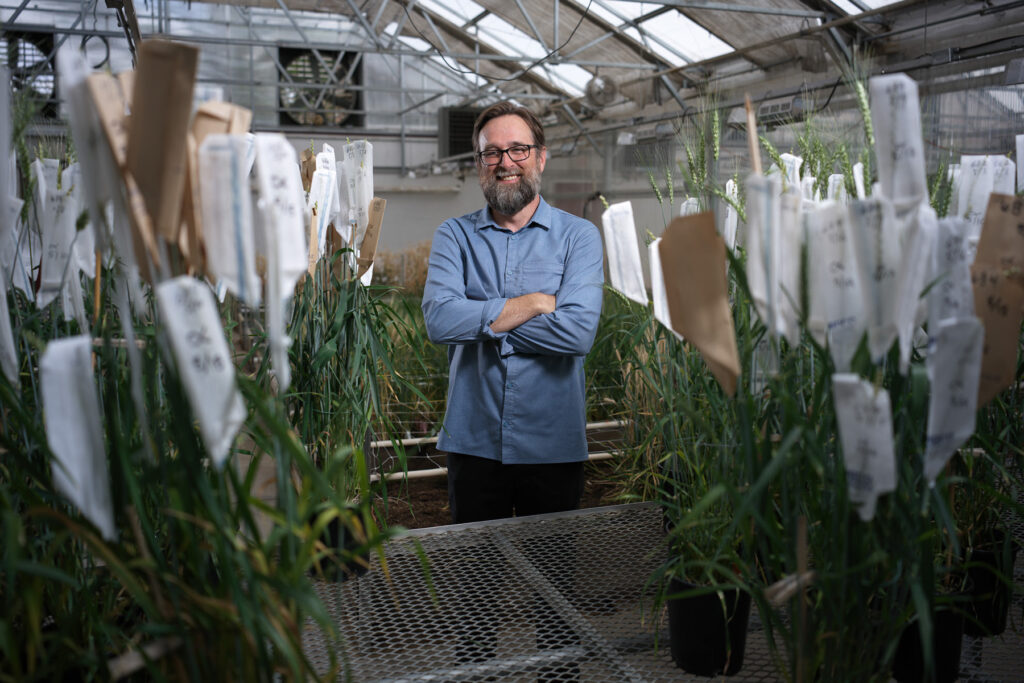
Professor Esten Mason leads the CSU Wheat Breeding and Genetics Program; it and the Colorado Potato Breeding and Selection Program produce patented plant varieties that annually generate more revenue for CSU than any other university intellectual property.
Loetscher’s lightbulb moment – the spark from his grandpa’s “tea” – is the very kind of scientific epiphany that often leads to promising inventions at top-tier research institutions, including Colorado State. In the past 10 years, CSU researchers have disclosed more than 1,000 inventions to CSU STRATA, the nonprofit corporation that helps protect and commercialize university innovations. Such inventions fuel technology transfer from universities to the marketplace and power the knowledge economy. At CSU, big ideas – call them intellectual property – yield nearly $3 million in revenue each year, mostly from patent licensing. This revenue is directed back to intellectual property management, faculty inventors, and CSU research and academics.
“What is the most important thing that comes out of a university, other than students? Intellectual property, and you have to protect it,” said Ajay Menon, president and chief executive officer of CSU STRATA.
Protections come in the form of patents, trademarks, and copyrights, instruments that define intellectual property and carve out rights to reproduce, use, and sell it. Sales matter to inventors, of course. They also matter to universities: In the past several decades, backed by federal legislation, many schools have enacted policies to benefit from commercialization of employee inventions. A well-known example from public research universities is Gatorade, the sports drink invented by a medical professor at the University of Florida. It was formulated in 1965 to perk up exhausted Florida Gators football players. Now, Gatorade reportedly energizes university research with about $20 million in trademark royalties each year.
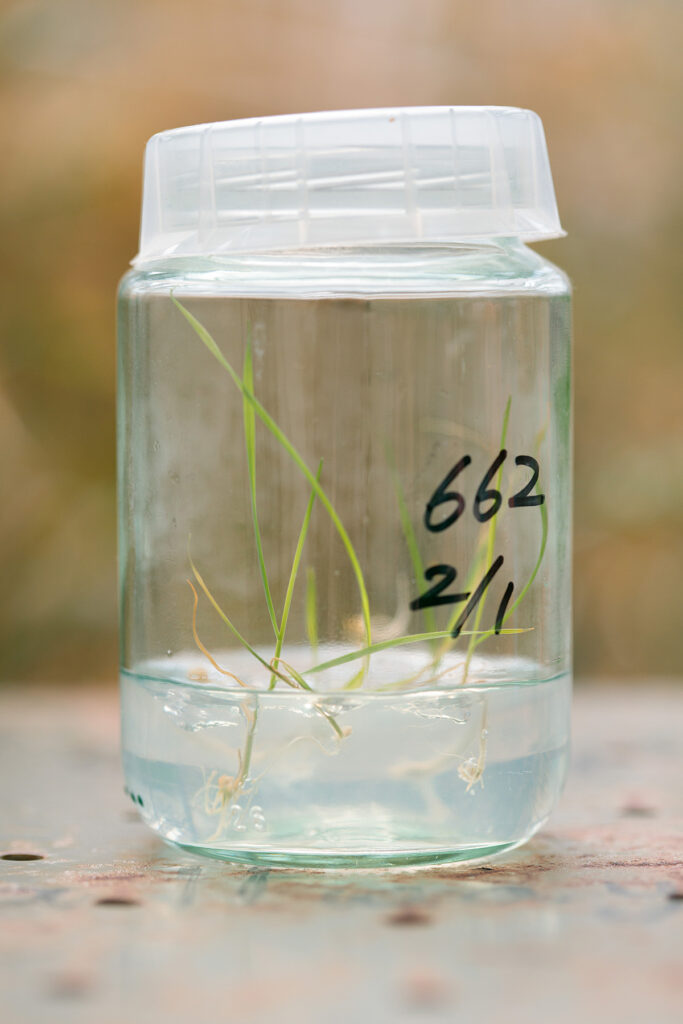
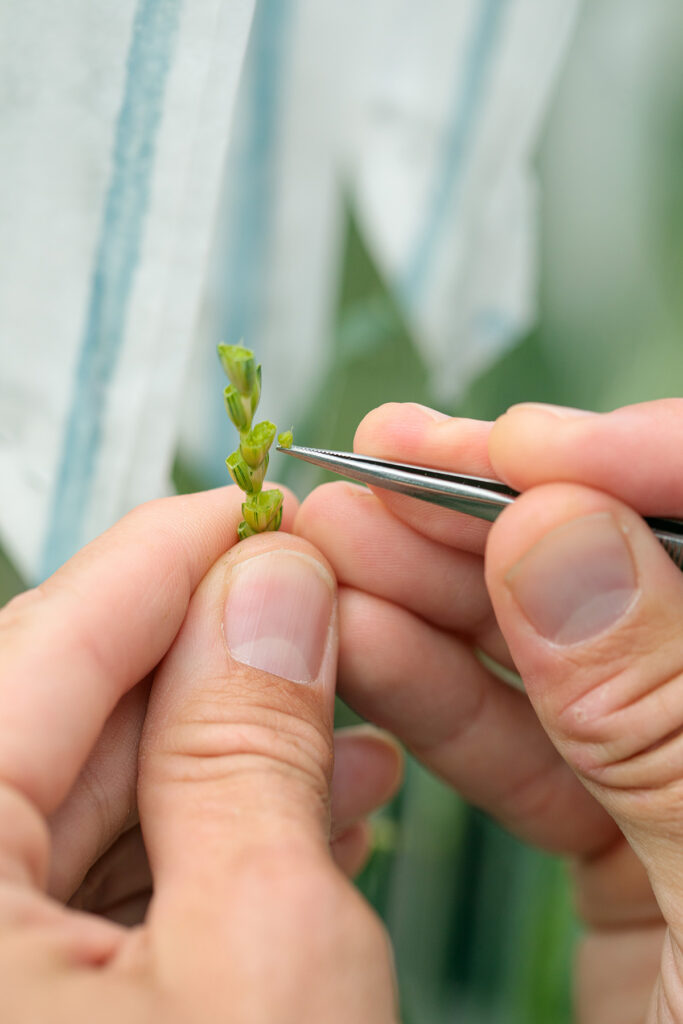
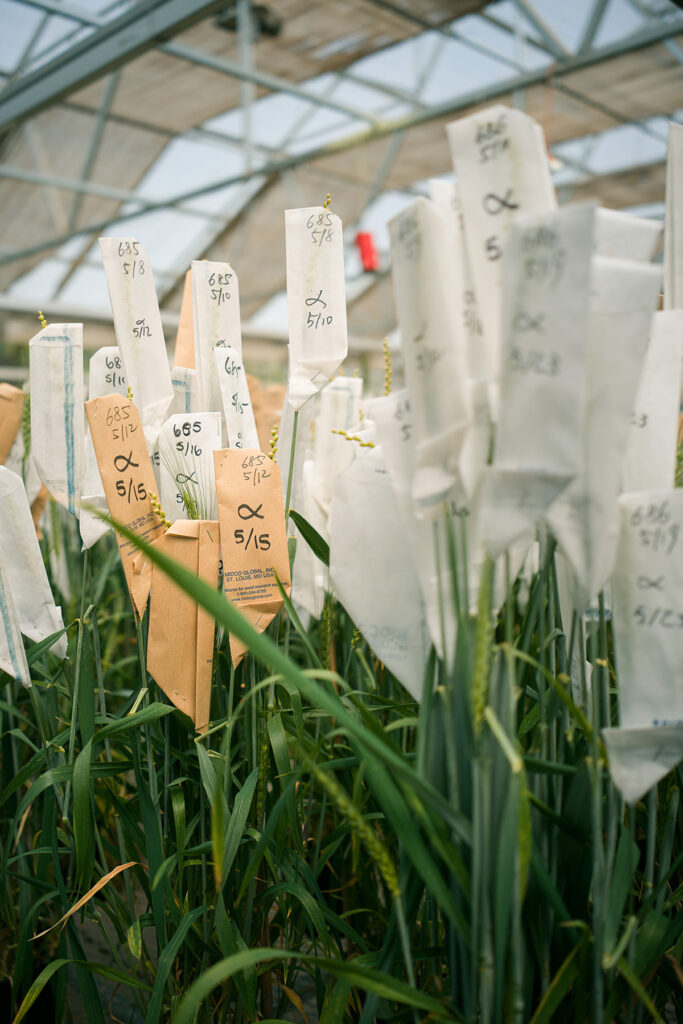
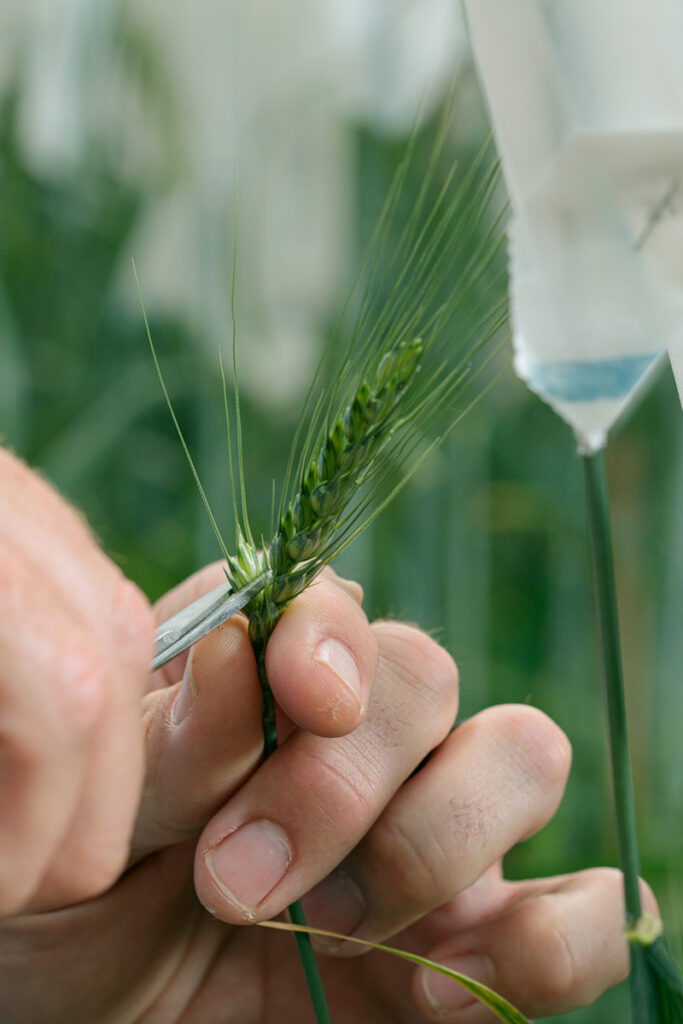
Unique varieties of wheat start with manual plant-breeding in a greenhouse. With success of these varieties, 90 percent of wheat grown in Colorado was developed at CSU.
COLORADO STATE UNIVERSITY HAS its own bread-and- butter innovations – emphasis on “bread.” Unique varieties of wheat and potatoes generate more revenue for CSU than any other intellectual property. The varieties are protected by about seven dozen plant patents and have returned nearly $2.5 million to CSU in the last three years alone, CSU STRATA records show. Most of this revenue is funneled back into wheat and potato research.
New wheat and potato cultivars result from years of disciplined science. With wheat, the process starts in a greenhouse. Here, student interns manually cross-pollinate plants for seed production: Using forceps, they pluck tiny anthers from thousands of wheat spikes, then join the anthers with florets on different plants, enabling fertilization and grain production. The process supplies seeds for a new generation of crossbred wheat plants that undergo trait analysis. Researchers sow and evaluate test crops in the field, assess yields at harvest, and conduct genomic analysis to pinpoint valuable traits. They even bake and appraise bread. New varieties of both wheat and potatoes rely on collaboration with Colorado farmers, who provide feedback about cultivars that perform best in the state’s harsh and increasingly dry climate.
Each year, CSU Wheat Breeding and Genetics releases between one and three new varieties, whittled down from about 4,000 under investigation. Recent successes include herbicide-tolerant cultivars, which allow farmers to kill weeds while sparing their wheat crops; and varieties with solid stems, which thwart the destructive wheat stem sawfly by closing the door on larvae development. That occurs because a wheat stem is typically hollow, so larvae have a den for maturation after an insect lays its eggs. But larvae cannot grow if the stem is solid; in fact, they suffocate.
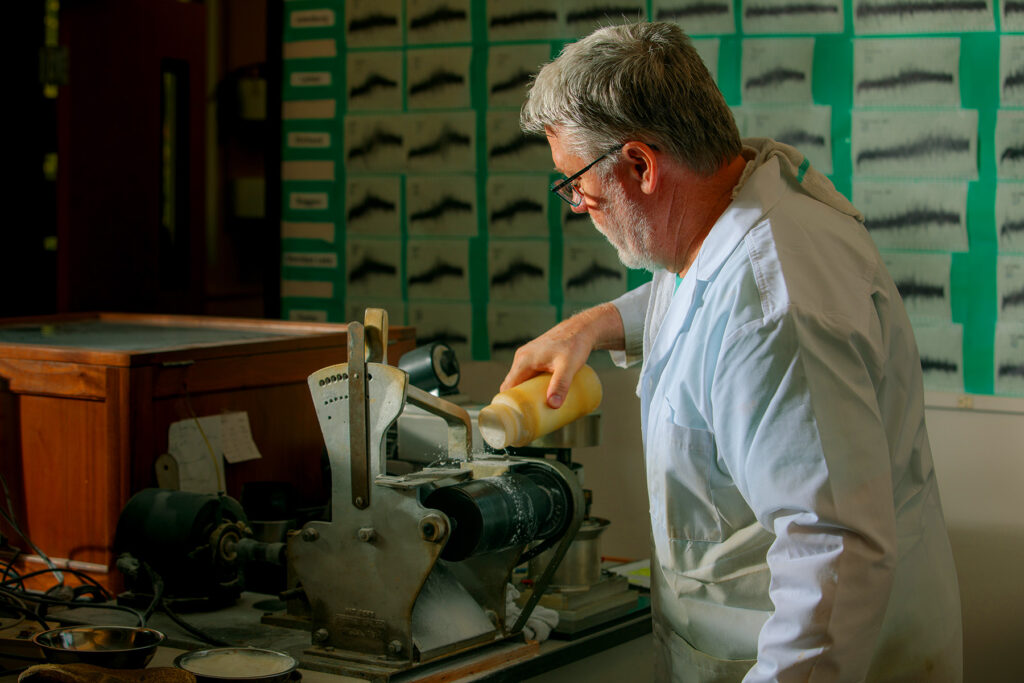
John Stromberger, a senior research associate in the Wheat Quality Lab, tests the baking qualities of flour milled from CSU’s wheat cultivars.
The ongoing challenge for researchers is responding to changing environmental variables, said Esten Mason, professor and project leader for CSU Wheat Breeding and Genetics. “We have a changing climate, with changing pests, changing disease, and changing weeds in the field, so we develop new varieties to address all those factors,” Mason said during a greenhouse tour. “The program is super productive and engaged with wheat farmers’ needs, which is why it’s so successful.”
Same goes with potatoes. The state’s spud farming is concentrated in the San Luis Valley, and the university’s Colorado Potato Breeding and Selection Program is based at a CSU research center in the thick of it. Since 1979, the program has released 37 patented potato cultivars; many are grown across the country and even in the United Kingdom, Australia, and Canada, said David Holm, a recently retired CSU horticulture professor who ran the program for decades. The potato program has co-released an additional two dozen cultivars with the U.S. Department of Agriculture and other organizations, said Holm, whose email address identifies him as “spudmkr.” Among its innovations, the research group developed potatoes with deep purple and reddish flesh, called Purple Majesty and Mountain Rose; papers published in scientific journals have noted their health attributes.
The result: Most of the wheat and potatoes grown in Colorado were developed at CSU, program leaders said. This production has helped boost wheat and potatoes into the top 10 agricultural commodities in Colorado, based on revenue, making the crops vital to the state’s $47 billion agricultural industry.
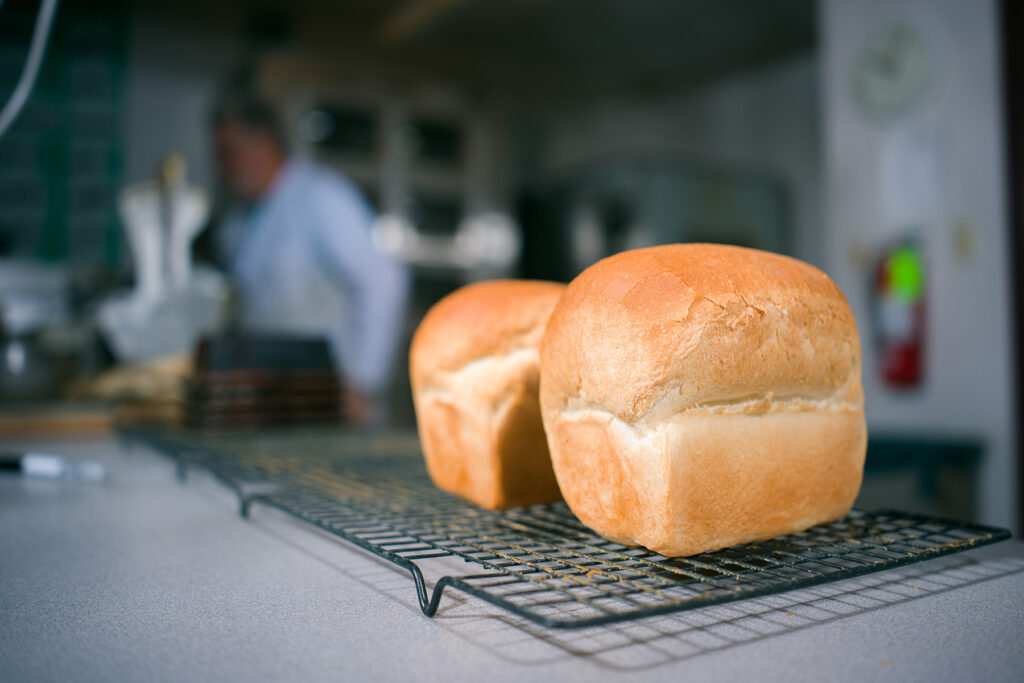
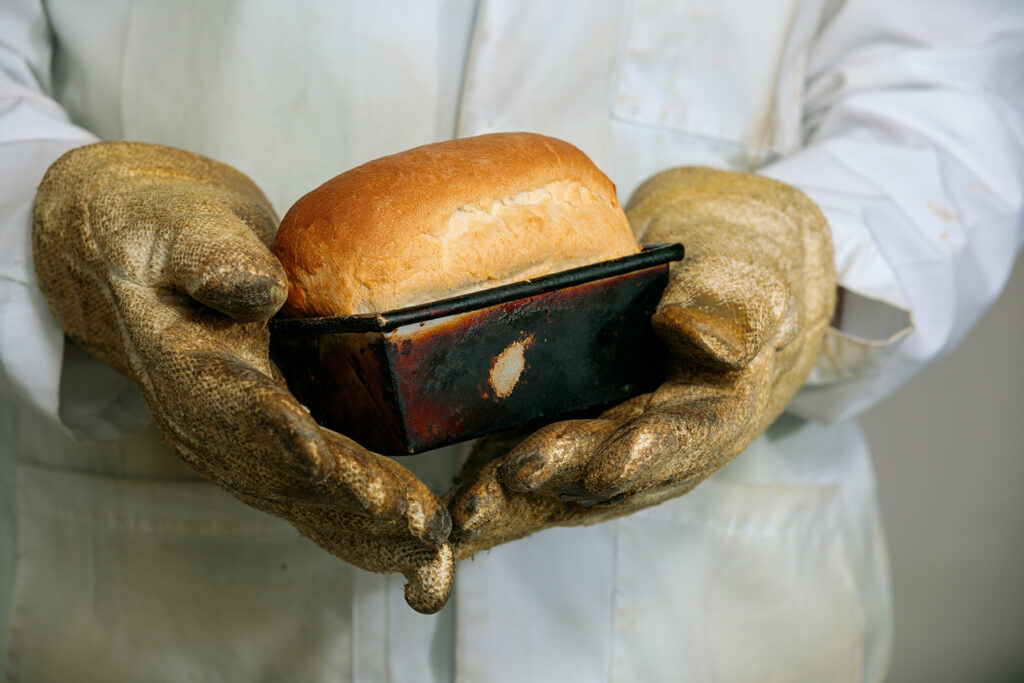
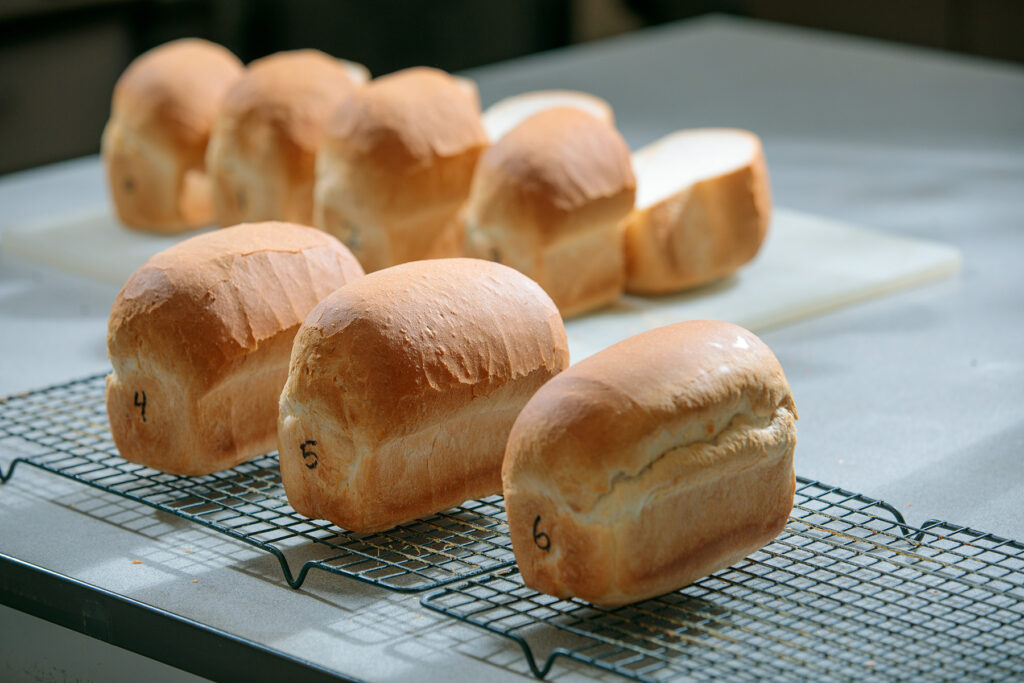
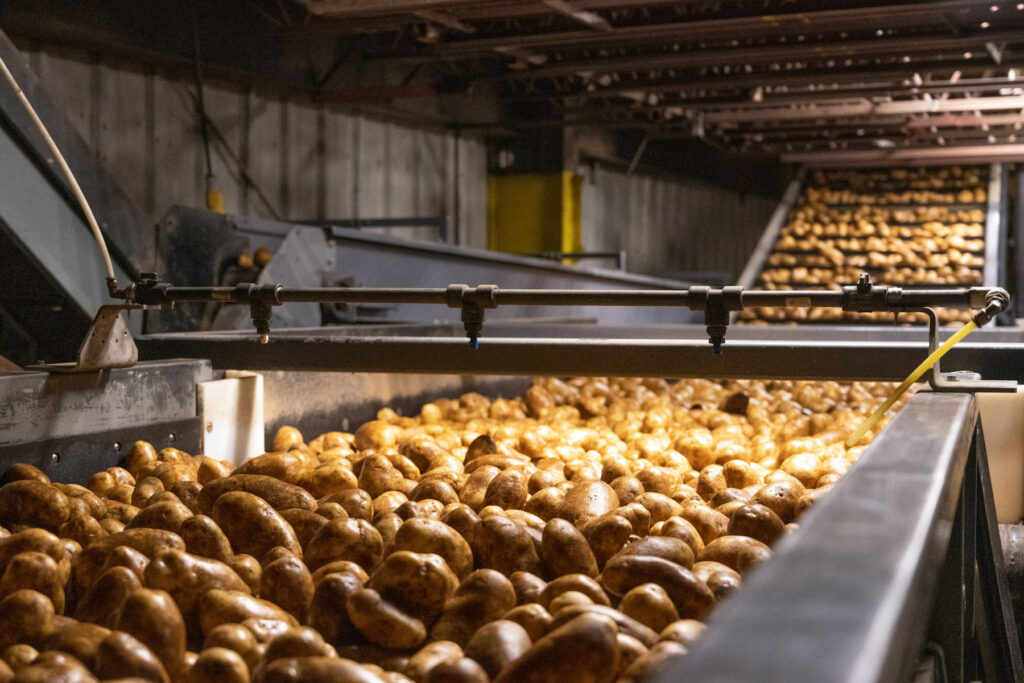
Loaves of bread are assessed for their rise; patented varieties of CSU russet potatoes are among those grown in fields in the San Luis Valley of Southern Colorado. Photo of potatoes by John Eisele / CSU Photography.
Every patent tells a story and offers a potential solution. For instance, the first patent on record at CSU STRATA was issued in 1967 to Dr. Alvin Hoerlein, a veterinarian and researcher, for a vaccine against bovine vibriosis, a venereal disease of cattle that causes infertility and abortion. It was commercialized by a company later acquired by pharmaceutical giant Pfizer. Early this year, CSU STRATA handed patent plaques to two dozen university researchers for an array of inventions. There was a patent for a new type of antimicrobial gel that could be used in wound dressings; a novel system using bacteria to control disease-transmitting mosquitoes; and a new kind of miniature walking robot produced with 3D printing that could be employed, for example, to search for survivors of disaster.
Patents represent an early step in moving inventions from the university to the marketplace. At CSU, this business activity is an important off shoot of a much larger research enterprise, measured last year by $457 million in research expenditures. Spending chiefly relies on federal grants to support new discoveries, often about how things work – from the atmosphere to the atom. Technology transfer extends these discoveries, as researchers create products, processes, and other innovations and move them into the marketplace.
“When we’re talking about intellectual property, it boils down to innovation,” said Molly Kocialski, Rocky Mountain regional director of the U.S. Patent and Trademark Office. “Every innovation that improves lives, advances society, and drives our economy starts with an idea,” she said during a campus event. “And every idea starts with a person and a big or little problem to be solved.”
In Colorado, Kocialski said, about 35 percent of private sector employees work in industries that depend on innovations protected by patents, trademarks, and copyrights; these industries include manufacturing, wholesale and retail trade, and professional services. Such industries account for nearly $8 trillion in annual output, representing about 40 percent of U.S. gross domestic product, according to the U.S. Patent and Trademark Office.
Technology transfer
the path of intellectual property from faculty laboratory to the marketplace
1. Big idea
Invention of novel product or process to solve a problem.
2. Disclosure
Inventor alerts CSU STRATA; vetting confirms invention is new and useful.
3. Protection
CSU STRATA files for patent, trademark, copyright, or other intellectual property protection from the U.S. Patent and Trademark Office. This identifies owner of the IP and prevents others from profiting.
4. Licensing
CSU STRATA and inventor find business partner to develop innovation into a commercially viable product or service; IP licensing fees support project, with some returned to CSU; royalties and other future payments agreed upon.
5. Startup
Inventor may establish or become affiliated with a startup company formed to license and develop the intellectual property.
6. Funding
Business partner handles multiple administrative demands; that includes recruiting investors to finance further R&D.
7. Marketplace
Innovation is perfected; launch plan is drawn; manufacturing and sales begin; licensing royalties are returned to CSU STRATA, inventors, and university.
UNMEASURED, HOWEVER, ARE the full benefits of university inventions for human and animal well-being, quality of life, and environmental health. These impacts become clear through stories of innovation and often are the reason researchers pursue technology transfer.
“New medicines on the shelves of clinics – that’s my motivation. To get something in clinics for animals and humans,” said Dr. Steven Dow, a veterinary researcher and professor of immunology at Colorado State. He is the rare faculty inventor to establish three startup companies. Two are moving immunotherapies for infections from laboratory to market; a third focuses on noninvasive technologies to diagnose and potentially treat inflammatory bowel disease. “It’s one of the main ways your work will make a difference,” Dow said of commercialization. “Your ideas may never make it into new drugs, but this work is a way to reach beyond research papers.”
All the technologies developed in Dow’s laboratory summon the body’s immune system to detect, prevent, or fight disease – kicking the internal bear to attack marauders. Moreover, all the laboratory’s innovations are aimed at both animal and human disease, Dow said. He might be a veterinarian, but Dow trained at National Jewish Health in Denver and, from the start of his medical career, has treated animals and researched their diseases as a path to solving health problems in both animals and people. This concept propels translational medicine, which recognizes similarities in animal and human diseases and applies discoveries in one to maladies in both.
Two years ago, translational medicine made headlines when a CSU startup called VetDC gained the first and only full approval from the U.S. Food and Drug Administration for a canine lymphoma treatment, which is marketed under the brand name Tanovea. The cancer drug was first pursued for use in humans. Then, VetDC – co-founded through a partnership with the CSU Flint Animal Cancer Center – saw potential for use in dogs and licensed the drug for commercialization. Now, Tanovea is sold by Elanco; it’s a significant step because lymphoma accounts for some 20 percent of cancer in dogs.
CSU FELLOWS OF THE NATIONAL ACADEMY OF INVENTORS
| NAME | YR ELECTED | INTELLECTUAL PROPERTY |
|---|---|---|
| The late George Seidel Jr. | 2014 | Livestock reproductive technologies |
| The late Edward Hoover | 2016 | Feline leukemia virus vaccine |
| V. Chandrasekar | 2020 | Weather radar |
| Susan James | 2020 | Medical devices |
| Steven Simske | 2021 | Sensing, imaging, and intelligent systems engineering |
DOW’S WORK IN translational medicine is influenced by the late Dr. Edward Hoover, another veterinary researcher and a star of CSU technology transfer as a past fellow of the National Academy of Inventors. Hoover, a former University Distinguished Professor and mentor for Dow, invented the first successful and most widely used vaccine against feline leukemia virus. Intellectual property protection was filed in the late 1980s, and it became the basis for a vaccine from Boehringer Ingelheim. But the significance of Hoover’s infectious disease research stretched well beyond animals. His studies of feline leukemia virus provided a model for better understanding immunodeficiencies in people, especially HIV/AIDS; his later research into chronic wasting disease in deer likewise related to studies of neurodegenerative disorders in people.
“All of our work has been focused on relevance to human health,” said Dow, who is director of the CSU Center for Immune and Regenerative Medicine. “Seeing our innovations work in canine patients, that de-risks a study for human trials. If it works in a veterinary setting, it’s much more likely to work in people.”
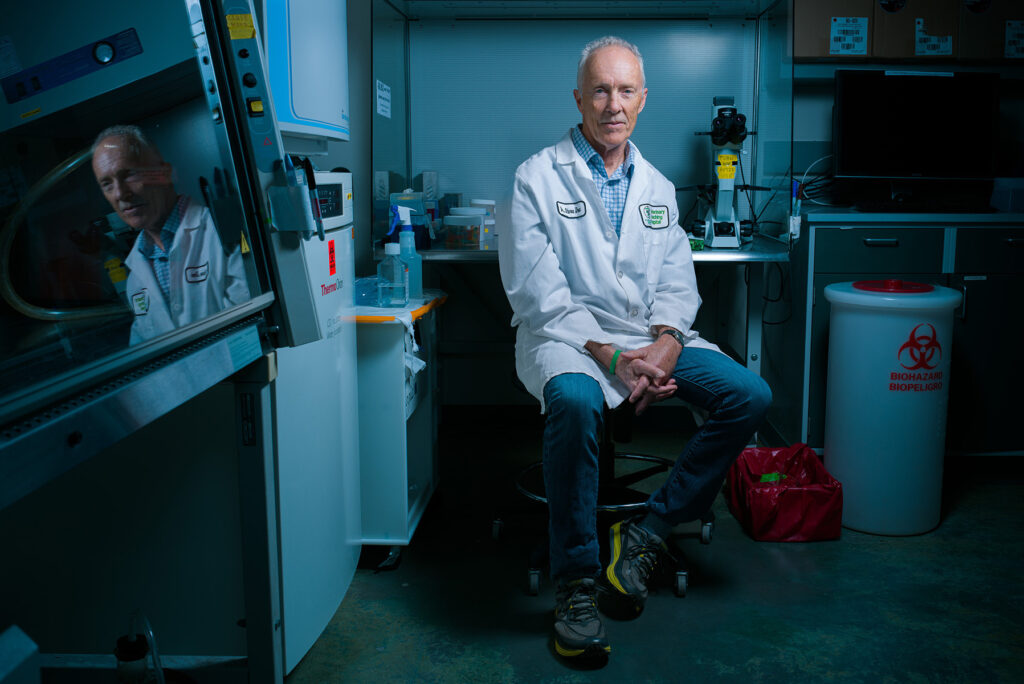
Professor Steven Dow, a research veterinarian and professor of immunology, is the rare faculty researcher to co-found three CSU startup companies to commercialize his medical innovations. They are Laporte Immunotherapeutics, Validus Cellular Therapeutics, and Quandary Diagnostics.
Startup companies often pay to license the patented innovations of their faculty founders or affiliated scientists. With rights to commercialize secured, companies start the heavy lifting needed to move inventions to market: raising venture capital, advancing research and development of technologies, and managing a slew of business needs, including legalities, market research, communications, and industry partnerships.
Notable among CSU startups is animal health firm Heska Corp., based in Loveland, Colorado. But it’s not a startup anymore. In April, Mars Inc. announced it is acquiring Heska in a deal valued at $1.3 billion. Mars is the world’s biggest candy company; it also is a heavyweight in pet care, as owner of VCA Animal Hospitals, a nationwide chain, and pet food brands Pedigree and Royal Canin.
When Heska started in 1988, it was known as Paravax. As the name implied, it formed to create vaccines that would protect pets against parasitic diseases, namely heartworm, and problems caused by fleas. The startup recruited and gained rights to the intellectual property of a rising scientist named Bob Grieve, who was researching parasite vaccines as an associate professor in the CSU College of Veterinary Medicine and Biomedical Sciences. Heska never made a parasite vaccine. But it did create dozens of diagnostic tools, allergy therapeutics, and other products used by veterinarians to treat dogs and cats in their clinics, including a fast-acting heartworm test. The company eventually went public, undertook restructuring during a tough time, and grew into a global operation, with reported annual revenue of $257 million in 2022 and more than 800 employees worldwide.
“There were twists and turns, for sure. But it was worthwhile,” Grieve said in a telephone interview from his home in northern Wyoming. He served as Heska chairman and CEO for about 15 years before retiring. “It’s very gratifying on a lot of levels and a credit to a lot of folks that we adjusted and adapted through the years,” Grieve said. “Our shareholders did well, our employees did well, our customers did well, and animals did well. That’s pretty cool.”
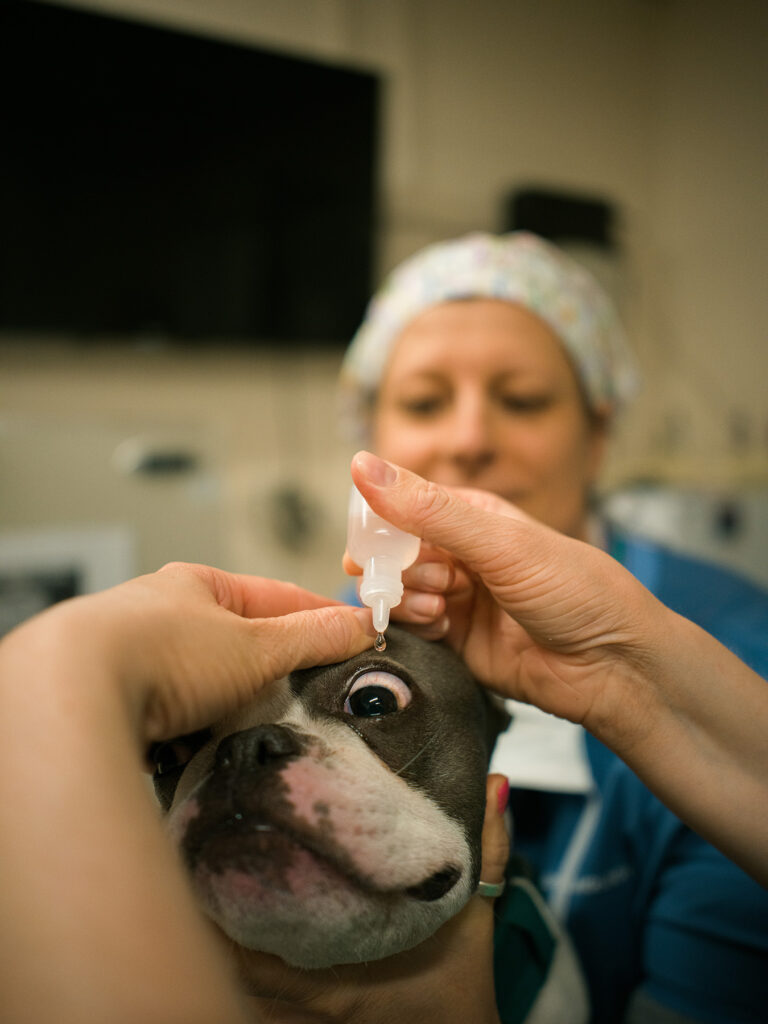
Eyedrops are administered to a dog at CSU’s James L. Voss Veterinary Teaching Hospital. Professor Steven Dow and his team invented the drops to treat eye infections in pets.
THROUGH THE YEARS, CSU intellectual property has been the basis of more than 90 startup companies, which have employed anywhere from a few people to a few hundred, CSU STRATA records show. These companies have economic muscle: In Northern Colorado, university startup and spinoff companies generate about $228 million in annual income for the region’s economy, according to a 2017-2018 study from Northern Colorado Public Colleges and Universities.
In the case of the solid waste digester, CSU STRATA filed an initial patent application on behalf of Loetscher and Sharvelle; it was granted in 2014. Seven additional patents are pending to protect parts of the innovation. Meantime, Loetscher co-founded a startup company called Fluent Renewables. With help from CSU STRATA, Fluent Renewables is developing digester technology into a product that potentially could be manufactured and sold.
To handle Fluent Renewables’ business concerns, a CSU STRATA program called Lab to Life Venture Studio spotted opportunity and jumped in with C-suite support; its team provides the startup with functions of a chief executive officer, chief operations officer, chief financial officer, and chief marketing officer. This business incubation includes legal work, market research, pitches to potential investors, the formation of industry connections that could help Fluent Renewables grow – and, ultimately, a go-to-market plan.
“We want to improve the chances of startup success by empowering scientists with business expertise. That way, we can keep the scientist in the lab perfecting their innovations,” said Jim Poss, director of venture creation for CSU STRATA. “The support is needed,” he added, “because the market has a way of being a pretty harsh critic.”
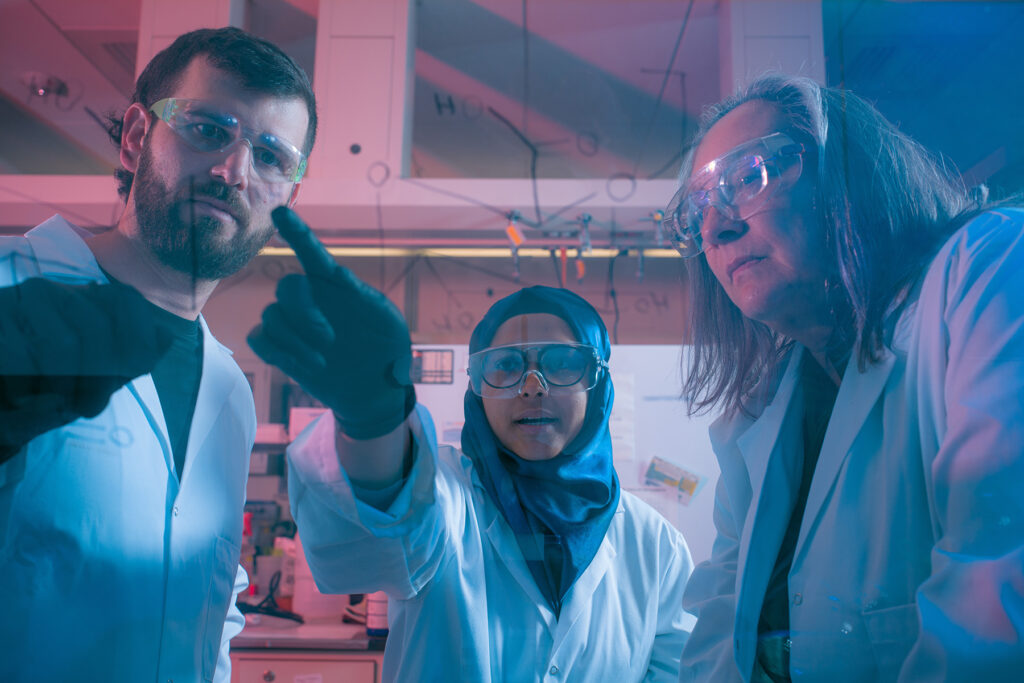
Professor Susan James, at right, is founding director of CSU’s School of Biomedical Engineering and is one of five CSU faculty researchers elected to the National Academy of Inventors. She invented and is working to commercialize an aortic valve replacement; assisting James are graduate students Justin Gangwish, left, and Nipa Khair, center.
Lab to Life launched last year and plans to annually undertake business development for four CSU startups. It is running with a $1.6 million grant, composed of an award from the U.S. Economic Development Administration and matching funds from CSU STRATA. In addition to Fluent Renewables, Lab to Life is supporting Curable Composites, a CSU startup developing use of 3D printing of carbon fiber composites that could transform manufacturing in aerospace and green energy; XLSOR, a company commercializing technology to accurately predict peak fruit harvesting and sales periods; and Quandary Diagnostics, co-founded by Dow to market a noninvasive test and potential cures for inflammatory bowel disease.
CSU STRATA also promotes university resources that accelerate innovation and tech transfer, including the C. Wayne McIlwraith Translational Medicine Institute, Food Innovation Center at CSU Spur, Infectious Disease Research Center, and Powerhouse Energy Campus.
How do these centers work? The Powerhouse Energy Campus, for example, is home to 15 startup companies investigating ways to solve energy challenges. One such company, called Envirofit International, got its start at the campus based on the intellectual property of co-founder and mechanical engineering Professor Bryan Willson and his co-inventors. Envirofit International specializes in clean, affordable cookstoves for indoor use in developing countries, with patented design meant to reduce carbon monoxide poisoning. The company has sold 1.6 million cookstoves around the world and has production and distribution centers in Central America, South America, Africa, and Asia.
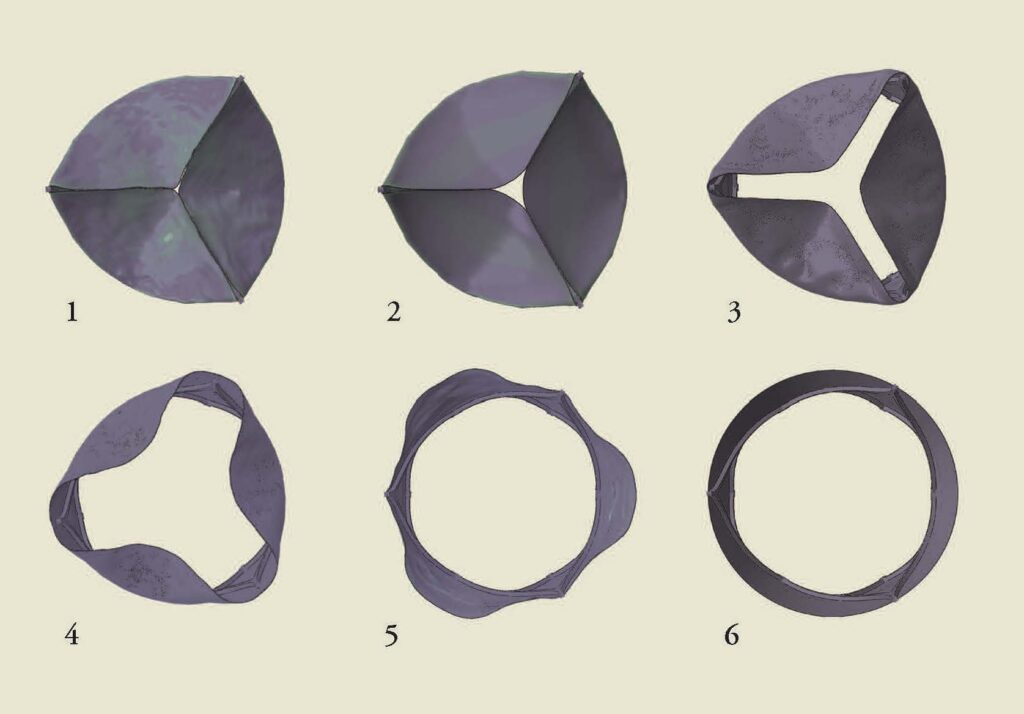

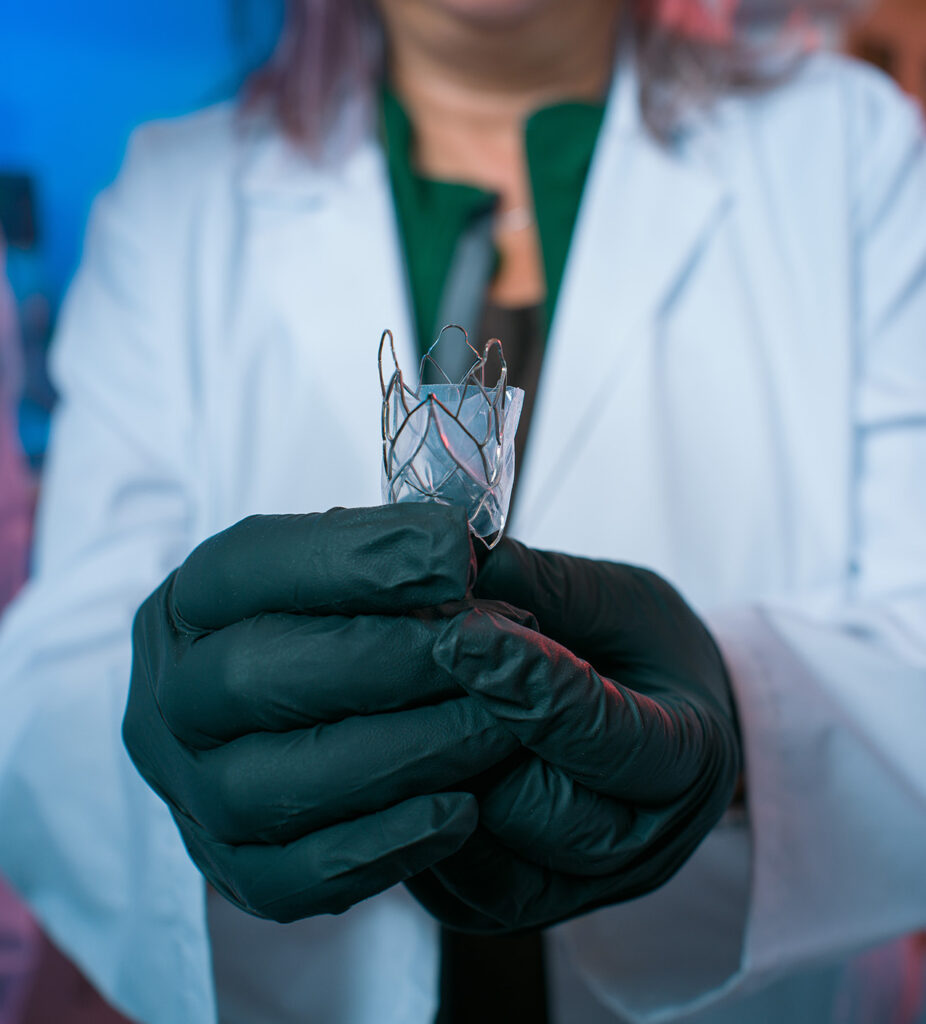
The new valve implant from Susan James and her colleagues is designed to function like an aortic valve, moving blood from the heart into and through the human body. The valve replacement is engineered with a polymeric material placed inside a stent, and includes fully functioning leaflets engineered to prevent blood clotting. The stop-action images (top left) show leaflets fully closed (1) to fully open (6). The valve could help treat the most common type of valvular heart disease and death in the developed world. Photo illustration: Nipa Khair / Diagram: YoungHeartValve
The new valve implant from Susan James and her colleagues is designed to function like an aortic valve, moving blood from the heart into and through the human body. The valve replacement is engineered with a polymeric material placed inside a stent, and includes fully functioning leaflets engineered to prevent blood clotting — the stop-action images (top) show leaflets fully closed (1) to fully open (6). The valve could help treat the most common type of valvular heart disease and death in the developed world. Photo illustration: Nipa Khair / Diagram: YoungHeartValve
YoungHeartValve is another startup addressing health concerns. The company is working to commercialize a device that could replace diseased aortic valves in the human heart. It is largely the brainchild of Susan James, vice provost for faculty affairs at CSU and founding director of the university’s School of Biomedical Engineering. Apart from other responsibilities, James is a prolific researcher, whose discoveries have resulted in three dozen patented innovations – a track record that makes her one of three current CSU fellows of the National Academy of Inventors. Before the valves, James invented implants to replace damaged cartilage in knee and toe joints; the devices were commercialized by an orthopedic implant company called BioPoly and are in clinical use.
Her valve implants could help treat aortic valve disease, the most common type of valvular heart disease and death in the developed world, according to the U.S. Centers for Disease Control and Prevention. The disease causes valve leaflets to malfunction, undermining the heart’s ability to move blood through the body. There are other aortic heart valve replacements on the market, but James’ implant offers a combination of catheter placement and construction with uniquely engineered material.
Her inventions rely on hyaluronan, a naturally occurring slippery substance that provides much of the body with a continuous “lube job,” she explained. It is found in eyes, joints, and skin. But you can’t just apply hyaluronan to polyethylene, a polymer commonly used to make medical implants. The substance must be embedded in the plastic material to produce the effect of constant lubrication, thus protecting surrounding tissues and blood cells. For instance, the addition of hyaluronan prevents bone degradation around a polyethylene joint implant. Used in an aortic valve replacement, hyaluronan helps blood flow smoothly and prevents clotting, James said. When polyethylene and hyaluronan are wedded – as they are in her inventions – the surface of an implanted medical device is like a Slip ’N Slide, and blood is the gleeful kid gliding over the engineered material, said Justin Gangwish, a doctoral student working with James.
“We’re going against evolution because we’re trying to put a synthetic material into your heart without your blood clotting. Hyaluronan makes the synthetic implant material work and look like a natural part of the body,” James said. “The dream is to get this new valve into people – that’s why we do it. It would be pretty revolutionary.”
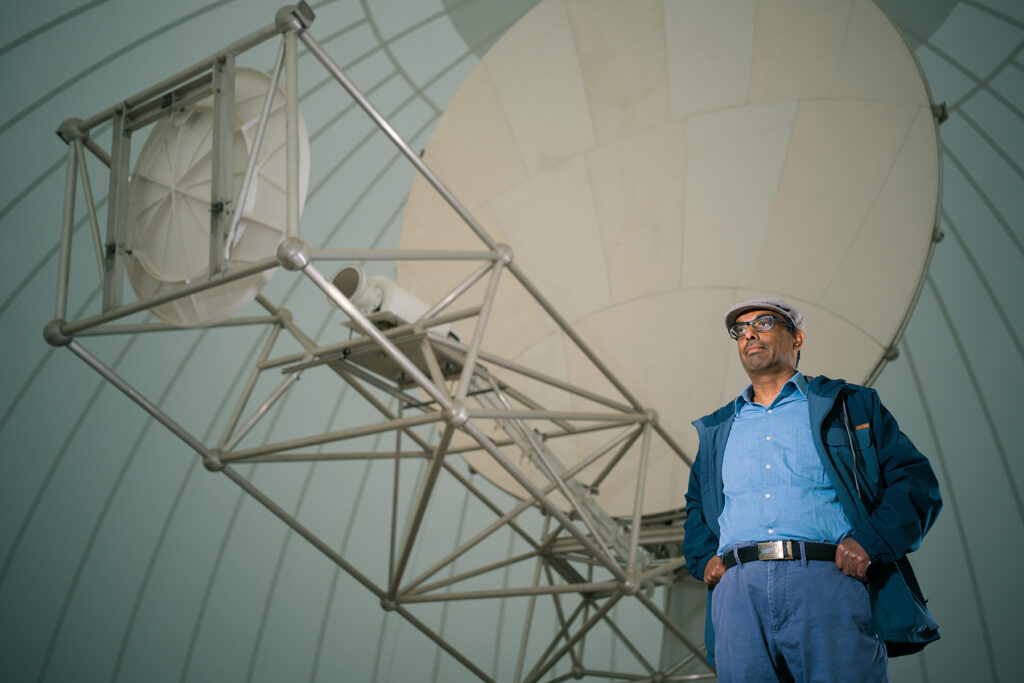
V. Chandrasekar is a University Distinguished Professor and fellow of the National Academy of Inventors who is a global expert in weather radar. He is a top CSU researcher based on number of university patents derived from federal research funding – some three dozen in all. He is shown with the CSU-CHILL radar, a one-of-a-kind system used by researchers worldwide for weather, climate, and atmospheric studies.
The notion of a new type of polymeric material for medical devices came to James after she worked as a graduate student with Dr. William Harris, a pioneering orthopedic surgeon and expert in hip replacements. Harris mentored James as she earned a doctorate in polymer science from the Massachusetts Institute of Technology. During that time, in the early 1990s, she witnessed the problems caused by polyethylene hip implants: The plastic material eventually caused bone loss in patients, so implanted devices loosened over time. A year after completing her Ph.D., James awoke in the middle of the night with a solution. She could engineer a new material, incorporating into polyethylene a substance with a lubricating effect. Hyaluronan fit the bill, and a few years later it became available as a natural molecule. For the past 25 years, James has made it the crux of her biomedical research.
The private sector is not the only pathway for university inventions. Government agencies are another route for innovations that make a difference in the world. A remarkable example comes in the work of CSU engineer V. Chandrasekar, a University Distinguished Professor and global expert in weather radar systems. “Chandra,” as he is widely known (or “Dr. Chandra” among many students and colleagues), has three dozen patents related to radar technologies and is among the university’s top researchers based on number of CSU patents derived from federal research funding, according to CSU STRATA. He leads significant programs for the National Science Foundation and NASA – helping to send weather radar into space – and has led several national experiments involving radars, aircraft, and ground instrumentation.
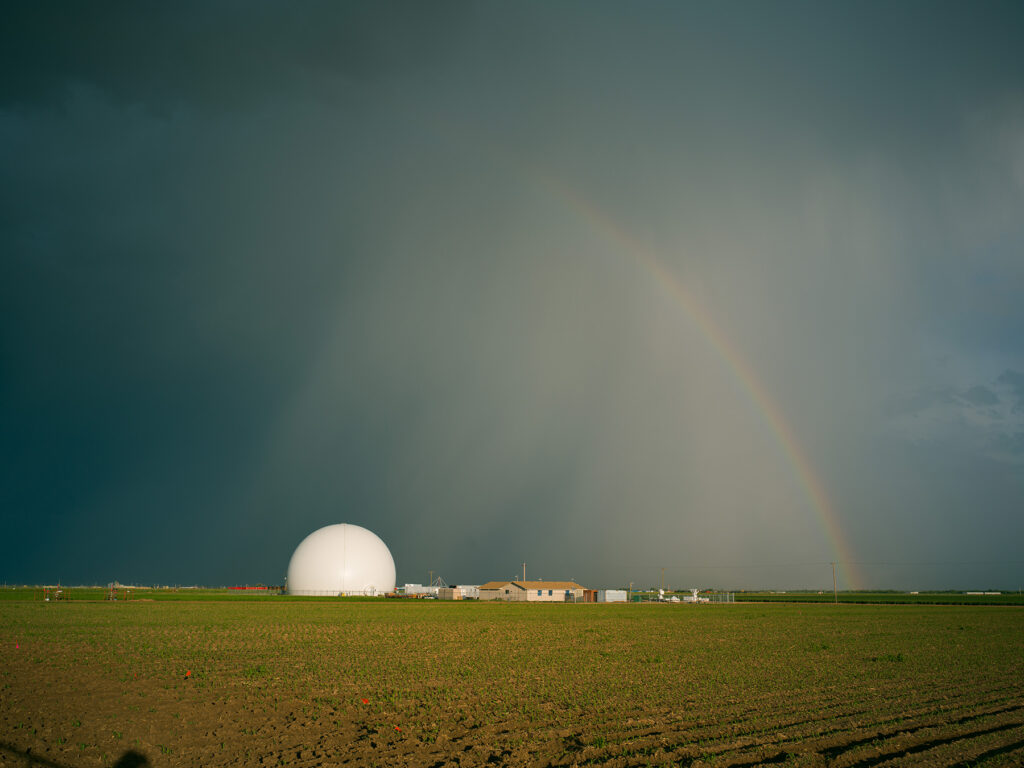

Left: The CSU-CHILL radar is hidden under a radome near Greeley, Colorado. Right: The radar system generated this image of a violent spring storm outside Greeley, Colorado.
Top: The CSU-CHILL radar is hidden under a radome near Greeley, Colorado. Bottom: The radar system generated this image of a violent spring storm outside Greeley, Colorado.
Chandra’s work centers on creating radar systems to detect and predict the severity of major storms, the kind that produce blizzards, hail, tornadoes, torrential rain, and flooding. His research is aimed at protecting lives and property, Chandra said. And it is increasingly important, he noted, as climate change spawns more severe weather events and global urbanization makes dense populations vulnerable, especially when buildings and infrastructure are not built to handle the onslaught.
“Water is a primary element of life – water controls our lives,” said Chandra, another fellow of the National Academy of Inventors. “So, lack of water is a problem. Too much water is a problem. The first step to dealing with that problem is to measure precipitation very accurately. Once we know how much water is coming in, we can manage it better.”
He has the perfect tool for the job in an enormous, state-of- the-art radar system known as CSU-CHILL. It was built in 1990 at a Colorado State University site near Greeley, Colorado, and is one of the most advanced meteorological radar systems for research in the world. (Its initial location in Chicago, Illinois, gave the system an acronym and a permanent name.) The radar is 65 feet tall, with a reflector 30 feet in diameter. It is housed under an inflated radome – a giant white bubble – made with the same material used for the mountainlike peaks that form the roof of Denver International Airport. The radar can gather data as far away as 100 miles in any direction, meaning it can take measurements well into Earth’s atmosphere. It could gather data from even farther away, but for “an inconvenient truth called the Earth’s curvature,” Chandra said.
Scientists around the globe use CSU-CHILL to gather data for a range of weather, climate, and atmospheric research. Much of this research then contributes to modeling and to forecasts produced by the National Weather Service. In his role as director, Chandra oversees data collection from this and other CSU radars. His team also uses CSU-CHILL as a staging site for new innovations. “It’s the sandbox where all the inventions happen – where we develop and test new things before they go out to the field,” he said.
CSU STRATA PORTFOLIO
The technology transfer unit of CSU STRATA protects, manages, and licenses intellectual property for the Colorado State University System. It formerly was known as the Colorado State University Research Foundation; the recent name change reflects additional layers of responsibility, including real estate and financing. CSU STRATA is a private, nonprofit corporation that is separate from the CSU System but supports its campuses and affiliates.
— Active inventions assigned to CSU: 777
— Total active licenses: 243
— Total startup companies in operation: 50+
As big as it is, CSU-CHILL takes the most minute measurements, not simply of storm systems, but of individual raindrops making up those systems – their size, shape, and velocity. “It’s very sensitive,” Chandra said. “This radar can see a swarm of insects flying over Denver.” From these precise observations, Chandra and other scientists may extrapolate and better understand characteristics of entire weather systems, including the amount of precipitation they are likely to produce.
But big radar is not Chandra’s only interest. He recognizes that massive radars, such as CSU-CHILL, may cost “tens of millions,” and many entities needing precise data don’t have those funds. So, Chandra and his team have developed smaller, relatively affordable radar systems, often in networks of multiple instruments. These are well-suited for mountainous and other complex terrain. In fact, the team has designed two weather radar systems installed near Crested Butte, Colorado, which are well-placed for observing precipitation in the critically important Colorado River Basin.
“I had no idea my life would turn into this,” Chandra said of his career as an inventor. “The most exciting thing is it’s being put to use beyond my wildest imagination.”
Photo at top: Lucas Loetscher, a Ph.D. student at Colorado State University, invented a new kind of digester to generate renewable natural gas from solid waste, including including cattle manure from feedlots like that shown. CSU STRATA is supporting Loetscher’s startup company, Fluent Renewables, with a new program called Lab to Life.
SHARE
